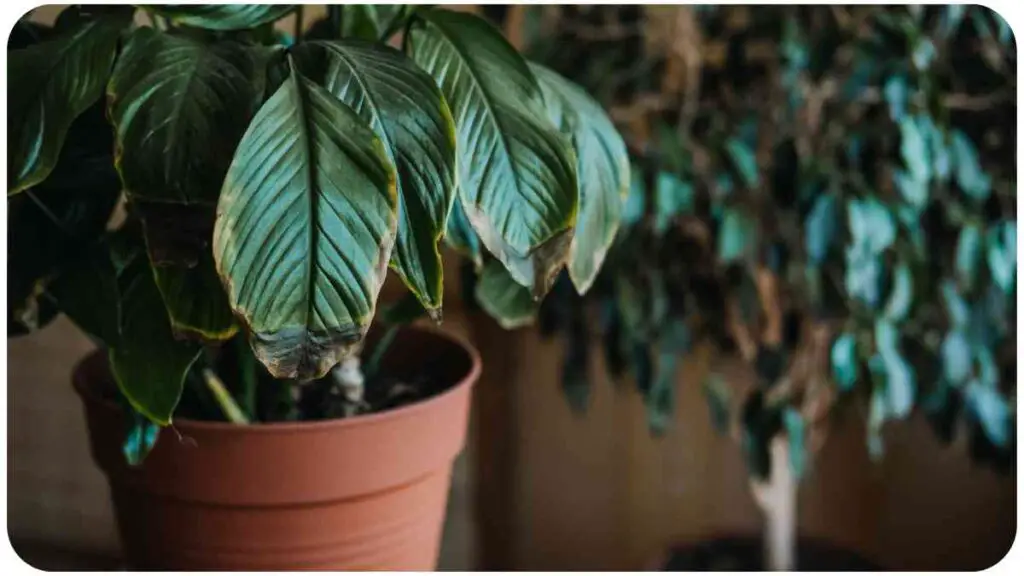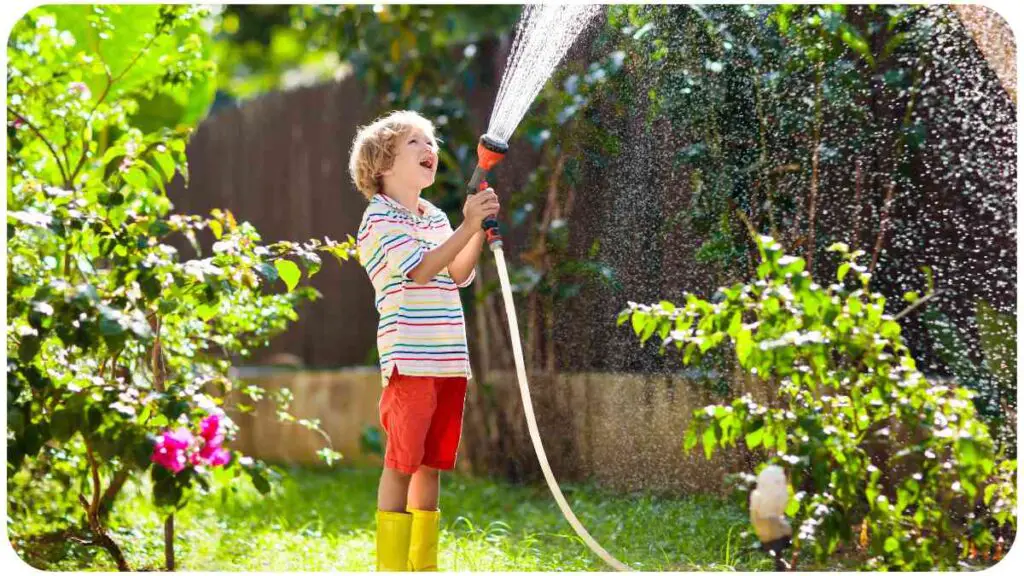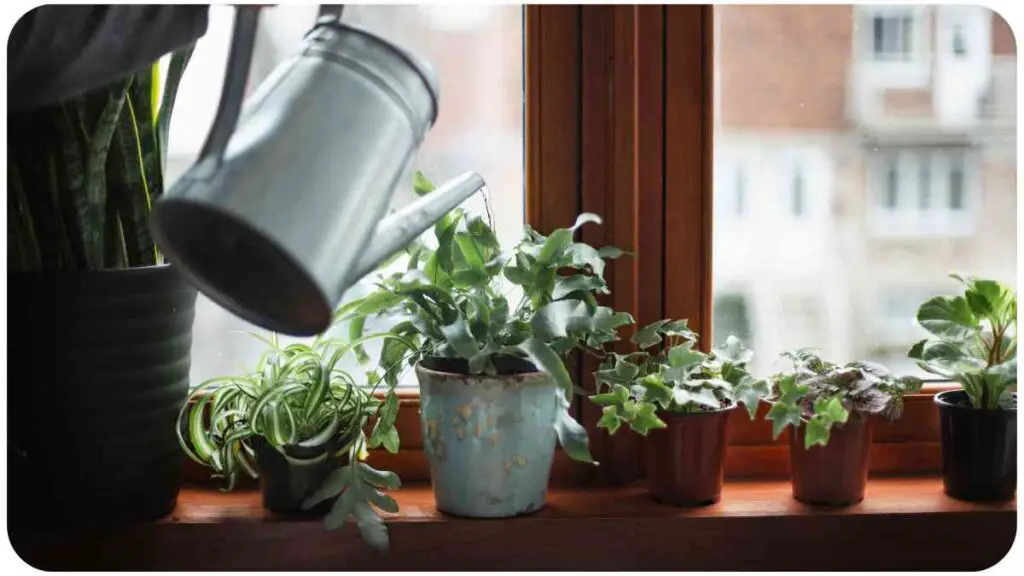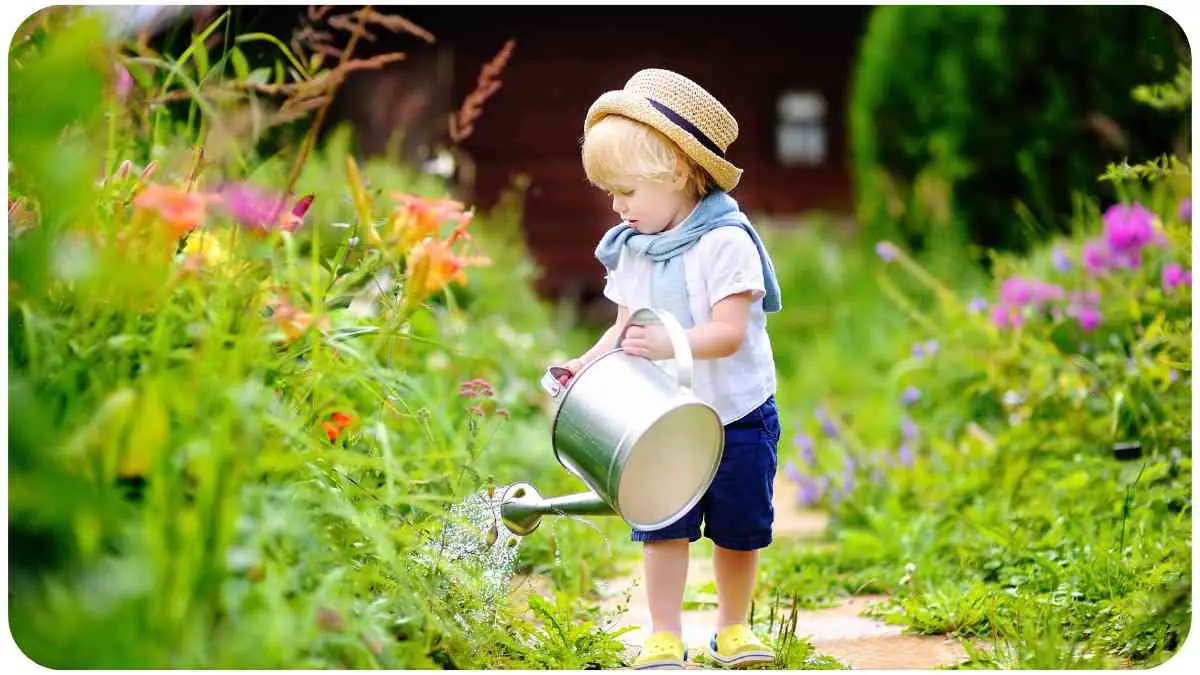As garden enthusiasts, we all want to shower our plants with care, and sometimes, quite literally with water. However, what if too much of a good thing turns detrimental? Overwatering is a common issue that can wreak havoc on your garden’s health.
In this guide, we’ll delve into the signs of overwatering, strategies for prevention, and expert insights to ensure your plants thrive.
| Takeaways |
|---|
| 1. Signs of Overwatering: Watch for yellowing leaves, wilting, and mold growth. |
| 2. Understanding Soil Moisture: Emphasize proper drainage and choose the right soil for different plants. |
| 3. Best Practices for Watering: Establish a consistent watering schedule and use appropriate techniques. |
| 4. Tools for Monitoring Soil Moisture: Invest in moisture meters and utilize DIY testing methods. |
| 5. Choosing the Right Plants: Opt for drought-tolerant options and match plants to specific soil types. |
| 6. Container Gardening Tips: Ensure proper drainage in containers and adjust watering frequency accordingly. |
| 7. Weather Considerations: Adapt watering practices based on seasonal changes and natural rainfall. |
| 8. Maintaining Healthy Roots: Prioritize root health through proper aeration and soil maintenance. |
| 9. Troubleshooting Overwatered Plants: Repot and prune strategically to recover overwatered plants. |
| 10. Success Stories and Expert Insights: Learn from real experiences and expert advice to enhance your gardening skills. |
| 11. Prevention is Key: Consistently monitor soil moisture and adjust watering practices based on plant responses. |
Signs of Overwatering

2.1 Yellowing Leaves
One of the first indicators of overwatering is the yellowing of leaves. This could be a sign that the roots are suffocating due to excess moisture, leading to nutrient deficiencies.
Enhance your gardening expertise by understanding fungal diseases in plants. Discover proactive identification methods and effective treatment strategies to ensure the health of your garden.
Table 1: Yellowing Leaves – Possible Causes and Solutions
| Cause | Solution |
|---|---|
| Overwatering | Adjust watering frequency |
| Poor drainage | Improve soil drainage |
| Nutrient imbalance | Use balanced fertilizer |
2.2 Wilting Despite Moist Soil
Contrary to common belief, wilting plants can also signify overwatering. When roots are waterlogged, they struggle to absorb oxygen, leading to wilting despite the soil being moist.
Table 2: Wilting Despite Moist Soil – Action Steps
| Indication | Recommended Action |
|---|---|
| Soil moisture high | Allow soil to dry between waterings |
| Check root health | Inspect roots for signs of rot |
| Adjust watering | Opt for a more balanced watering schedule |
2.3 Mold and Fungus Growth
Excessive moisture creates an ideal environment for mold and fungus to thrive. If you notice mold growth on the soil surface or on your plant, it’s time to reassess your watering habits.
Elevate your outdoor oasis with these DIY garden fountain maintenance tips. Learn the secrets to maintaining clear water flow in your fountain, ensuring a serene and visually appealing focal point for your garden.
Table 3: Mold and Fungus Growth – Remedial Measures
| Issue | Remedial Action |
|---|---|
| Improve ventilation | Increase airflow around plants |
| Adjust watering | Allow soil to dry before next watering |
| Use fungicides | Apply appropriate fungicidal treatment |
2.4 Root Rot
Root rot is a serious consequence of overwatering, causing the roots to decay. It’s crucial to identify and address this issue promptly.
Table 4: Root Rot – Emergency Measures
| Signs of root rot | Immediate Actions |
|---|---|
| Foul odor from soil | Remove affected plant from soil |
| Brown, mushy roots | Trim affected roots, repot in dry soil |
| Treat with fungicide | Apply fungicide as a preventive measure |
Understanding Soil Moisture Levels
3.1 Importance of Proper Drainage
Ensuring proper drainage is essential in preventing overwatering. Well-draining soil allows excess water to escape, preventing it from pooling around the roots.
Cultivate a healthier garden environment by exploring common drainage issues and effective fixes. Enhance your gardening experience with improved soil drainage, promoting optimal plant growth and vitality.
Table 5: Proper Drainage – Factors to Consider
| Factors to Assess | Recommendations |
|---|---|
| Soil composition | Choose well-draining soil mix |
| Container drainage holes | Ensure containers have adequate holes |
| Mulching | Use mulch to regulate soil moisture |
3.2 Choosing the Right Soil
Selecting the right soil is a key factor in maintaining optimal moisture levels for your plants. Different plants have varying soil requirements, and understanding these can make a significant difference in preventing overwatering.
Table 6: Soil Types for Different Plants
| Plant Type | Recommended Soil Type |
|---|---|
| Succulents | Sandy, well-draining soil |
| Tropical Plants | Peat-based mix with good drainage |
| Vegetables | Loamy soil with organic matter |
| Ferns | Rich, moisture-retentive soil |
Best Practices for Watering

4.1 Establishing a Watering Schedule
Creating a consistent watering schedule helps in maintaining the right moisture balance for your plants. Consider the specific needs of each plant species in your garden.
Table 7: Watering Schedule – General Guidelines
| Plant Type | Frequency of Watering |
|---|---|
| Drought-tolerant | Infrequent, deep watering |
| Moisture-loving | Regular, consistent watering |
| Seasonal Adjustments | Adapt watering to weather changes |
4.2 Watering Techniques
The method of watering can impact how effectively your plants absorb moisture. Employing the right watering techniques can minimize the risk of overwatering.
Revitalize your garden soil using these essential tips and techniques. Learn the art of soil rejuvenation to create an optimal foundation for a thriving and lush garden.
Table 8: Watering Techniques – Tips for Success
| Technique | Guidelines |
|---|---|
| Water at root level | Direct water to the base, not foliage |
| Morning watering | Minimize evaporation, reduce fungal growth |
| Use a drip irrigation system | Control water distribution accurately |
Tools for Monitoring Soil Moisture
5.1 Moisture Meters
Investing in a moisture meter can be a game-changer in preventing overwatering. These handy devices provide real-time information about soil moisture levels.
Table 9: Moisture Meters – Popular Options
| Brand | Features |
|---|---|
| Dr. Soil | Digital display, easy to use |
| SoilSense | Wireless, connects to mobile app |
| GreenThumb | 3-in-1 meter (moisture, pH, light) |
5.2 DIY Testing Methods
If you prefer a hands-on approach, several DIY methods can help you assess soil moisture levels without the need for specialized equipment.
Table 10: DIY Testing Methods – Quick Checks
| Method | Indication |
|---|---|
| Finger Test | Feel soil moisture with your finger |
| Stick Test | Insert a stick into the soil, observe moisture |
Choosing the Right Plants
6.1 Drought-Tolerant Options
Opting for drought-tolerant plants is a strategic move to reduce the risk of overwatering. These resilient species can thrive with less frequent watering.
Ensure the stability of your garden structures with expert tips on fixing wobbly pergolas, arbors, and more. Safeguard your outdoor spaces by addressing structural issues for lasting durability and aesthetic appeal.
Table 11: Drought-Tolerant Plants – Excellent Choices
| Plant Type | Characteristics |
| Lavender | Drought-resistant, fragrant blooms |
| Agave | Succulent, minimal water needs |
| Yarrow | Tolerates dry conditions, attracts pollinators |
6.2 Matching Plants to Soil Types
Understanding the soil preferences of your plants is crucial. Matching the right plants to specific soil types ensures they receive the appropriate level of moisture.
Table 12: Plant-Specific Soil Requirements
| Plant Type | Ideal Soil Type |
|---|---|
| Azaleas | Acidic, well-draining soil |
| Cacti | Sandy, fast-draining mix |
| Hostas | Rich, moisture-retentive soil |
Container Gardening Tips

7.1 Proper Drainage in Containers
Container gardening poses unique challenges, but with proper attention to drainage, you can maintain a healthy balance for your potted plants.
Table 13: Container Drainage Tips
| Container Type | Drainage Recommendations |
|---|---|
| Terracotta pots | Use pots with drainage holes |
| Elevated containers | Add a layer of gravel at the bottom |
| Self-watering pots | Monitor water levels regularly |
7.2 Adjusting Watering Frequency
Container plants may require more frequent watering due to limited soil volume. Adjusting your watering frequency accordingly is key to preventing overwatering.
Table 14: Container Watering Guidelines
| Container Size | Recommended Watering Frequency |
|---|---|
| Small pots | More frequent, smaller amounts |
| Large containers | Less frequent, but deep watering |
| Hanging baskets | Check moisture levels regularly |
Weather Considerations
8.1 Seasonal Adjustments
Adapting your watering routine to seasonal changes is essential. Different weather conditions demand varying approaches to prevent overwatering.
Table 15: Seasonal Watering Adjustments
| Season | Watering Considerations |
|---|---|
| Summer | Increase frequency during hot spells |
| Winter | Reduce watering, monitor soil moisture |
8.2 Rainfall Impact
Taking into account natural rainfall is crucial. Adjusting your watering schedule based on the amount of rain your garden receives helps maintain a healthy moisture balance.
Table 16: Rainfall Impact – Adapting Watering Practices
| Rainfall Amount | Watering Adjustment |
|---|---|
| Heavy rain | Skip scheduled watering, monitor soil |
| Prolonged drought | Increase watering frequency |
Maintaining Healthy Roots
9.1 Importance of Root Health
Healthy roots are the foundation of a thriving garden. Regularly monitoring and maintaining root health is a proactive approach to preventing overwatering issues.
Table 17: Root Health – Signs and Solutions
| Signs of Healthy Roots | Maintenance Tips |
|---|---|
| White, firm roots | Maintain consistent watering schedule |
| Adequate root growth | Avoid compacted soil, aerate regularly |
| Soil structure | Add organic matter for optimal growth |
9.2 Aerating the Soil
Soil aeration is crucial for promoting oxygen flow to the roots. Compacted soil hinders proper aeration, increasing the risk of overwatering.
Table 18: Aerating the Soil – Techniques
| Aeration Method | Frequency |
|---|---|
| Fork or spike aerator | Once a season, or as needed |
| Core aeration machine | Annually in late spring or fall |
| Mulching | Regularly to improve soil structure |
Troubleshooting Overwatered Plants
10.1 Repotting Strategies
If you suspect overwatering has already impacted your plants, timely repotting can help salvage the situation.
Table 19: Repotting Guidelines for Overwatered Plants
| Symptoms | Repotting Steps |
|---|---|
| Wilting despite moisture | Inspect roots, trim damaged parts |
| Mold or fungus growth | Remove affected soil, replant in dry mix |
| Waterlogged soil | Repot in well-draining soil, adjust watering |
10.2 Pruning Excess Foliage
Pruning can aid in the recovery of overwatered plants by reducing the demand for water and encouraging new, healthier growth.
Table 20: Pruning for Recovery
| Pruning Consideration | Pruning Techniques |
|---|---|
| Yellowing leaves | Trim affected foliage, promote new growth |
| Dense foliage | Thin out overcrowded areas |
| Affected branches | Remove damaged parts, encourage new shoots |
Success Stories and Expert Insights
11.1 John’s Journey to Healthy Plants
John, a gardening enthusiast, once faced severe overwatering issues in his garden. By adjusting his watering schedule, choosing drought-tolerant plants, and implementing proper drainage, he transformed his garden into a lush, thriving oasis. John’s experience highlights the transformative power of addressing overwatering challenges.
11.2 Expert Tips from Dr. Green Thumb
Dr. Green Thumb, a renowned horticulturist, emphasizes the importance of understanding each plant’s unique needs. According to Dr. Green Thumb, “Effective gardening is about finding the delicate balance between providing enough water for growth and preventing waterlogged roots. Pay attention to your plants, and they’ll tell you what they need.”
Prevention is Key
12.1 Consistent Monitoring
The key to preventing overwatering is consistent monitoring. Regularly check soil moisture levels, observe plant behavior, and be proactive in adjusting your watering practices accordingly.
Table 21: Monitoring Checklist
| Monitoring Aspect | Recommended Actions |
|---|---|
| Soil moisture levels | Use moisture meters, conduct DIY tests |
| Plant appearance | Look for signs of wilting, yellowing |
| Weather conditions | Adjust watering based on season, rainfall |
12.2 Adjusting Watering Practices
Adapting your watering practices to the specific needs of your plants is an ongoing process. Learn from your garden, make necessary adjustments, and be open to experimenting with different strategies.
Table 22: Adaptive Watering Strategies
| Plant Response | Adjustments Needed |
|---|---|
| Wilting or yellowing | Reduce watering frequency |
| Slow growth | Assess soil drainage, adjust watering |
| Mold or fungus growth | Improve ventilation, reduce watering |
Conclusion
In the vibrant world of gardening, conquering overwatering challenges is a vital step toward cultivating a flourishing garden. By understanding the signs, implementing best practices, and learning from both personal experiences and expert insights, you can ensure your garden remains a source of joy and beauty. Remember, a balanced approach to watering is the key to a thriving, resilient garden.
As you embark on this journey, let the passion for your plants guide you, and may your garden blossom with health and vitality. Happy gardening!
Further Reading
- Homes and Gardens – Overwatering Outdoor Plants
This comprehensive guide from Homes and Gardens explores the signs and consequences of overwatering outdoor plants. It provides practical tips on recognizing overwatering issues and offers solutions to help your garden thrive. - Flower Power – Save an Overwatered Plant
Flower Power’s gardening advice covers how to save an overwatered plant. The article provides actionable steps to revive waterlogged plants, ensuring they bounce back to health. - Love Me Mini – Fixing an Overwatered Plant: A Step-by-Step Guide
Love Me Mini offers a step-by-step guide on fixing an overwatered plant. This resource provides detailed insights and actionable steps to nurse your plants back to optimal health.
FAQs
How can I tell if my plants are being overwatered?
Overwatering signs include yellowing leaves, wilting despite moist soil, mold growth, and root rot. Monitor your plants for these indicators.
What are the consequences of overwatering outdoor plants?
Overwatering can lead to root rot, mold and fungus growth, and nutrient deficiencies. It suffocates roots, hindering their ability to absorb oxygen.
How often should I water my plants to prevent overwatering?
Establish a watering schedule based on the specific needs of your plants. Drought-tolerant plants may require infrequent watering, while moisture-loving ones may need more consistent watering.
Can I save an overwatered plant, or is it too late?
In many cases, overwatered plants can be saved. Quick actions such as repotting in well-draining soil, pruning affected parts, and adjusting watering practices can contribute to recovery.
Are there specific plants that are more prone to overwatering?
Plants with sensitive root systems, such as succulents and cacti, are more prone to overwatering. Understanding the water needs of different plant types is essential to prevent overwatering.

Hi! My name is Hellen James, and I’m here to help you with your home-maintenance needs. Whether it’s building a better yard or just trying to fix a garden—I can show you how.


